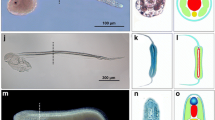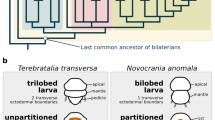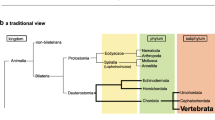Abstract
One of the definitive characteristics of chordates (cephalochordates, vertebrates) is the somites, which are a series of paraxial mesodermal blocks exhibiting segmentation. The presence of somites in the basal chordate amphioxus and in vertebrates, but not in tunicates (the sister group of vertebrates), suggests that the tunicates lost the somites secondarily. Somites are patterned from anterior to posterior during embryogenesis. How such a segmental pattern evolved from deuterostome ancestors is mysterious. The classic enterocoel theory claims that chordate mesoderm evolved from the ancestral deuterostome mesoderm that organizes the trimeric body parts seen in extant hemichordates. Recent progress in molecular embryology has been tremendous, which has enabled us to test this classic theory. In this review, the history of the study on the evolution of the chordate mesoderm is summarized. This is followed by a review of the current understanding of genetic mapping on anterior/posterior (A/P) mesodermal patterning between chordates (cephalochordates, vertebrates) and a direct developing hemichordate (Saccoglossus kowalevskii). Finally, a possible scenario about the evolution of the chordate mesoderm from deuterostome ancestors is discussed.






Similar content being viewed by others
References
Adachi N, Kuratani S (2012) Development of head and trunk mesoderm in the dogfish, Scyliorhinus torazame: I. Embryology and morphology of the head cavities and related structures. Evol Dev 14:234–256. https://doi.org/10.1111/j.1525-142X.2012.00542.x
Adachi N, Takechi M, Hirai T, Kuratani S (2012) Development of the head and trunk mesoderm in the dogfish, Scyliorhinus torazame: II. Comparison of gene expression between the head mesoderm and somites with reference to the origin of the vertebrate head. Evol Dev 14:257–276. https://doi.org/10.1111/j.1525-142X.2012.00543.x
Aronowicz J, Lowe CJ (2006) Hox gene expression in the hemichordate Saccoglossus kowalevskii and the evolution of deuterostome nervous systems. Integr Comp Biol 46:890–901. https://doi.org/10.1093/icb/icl045
Balfour FM (1877) The development of elasmobranch fishes. J Anat Physiol 11:406–490
Balfour FM (1878) A monograph on the development of elasmobranch fishes. Macmillan, London
Bateson W (1885) The later stages in the development of Balanoglossus kowalevskii, with a suggestion as to the affinities of the Enteropneusta. Q J Microsc Sci 2:81–122
Bateson W (1886) The ancestry of the chordata. Q J Microsc Sci 26:535–571
Beaster-Jones L, Kaltenbach SL, Koop D, Yuan S, Chastain R, Holland LZ (2008) Expression of somite segmentation genes in amphioxus: a clock without a wavefront? Dev Genes Evol 218:599–611. https://doi.org/10.1007/s00427-008-0257-5
Candiani S, Holland ND, Oliveri D, Parodi M, Pestarino M (2008) Expression of the amphioxus Pit-1 gene (AmphiPOU1F1/Pit-1) exclusively in the developing preoral organ, a putative homolog of the vertebrate adenohypophysis. Brain Res Bull 75:324–330. https://doi.org/10.1016/j.brainresbull.2007.10.023
Conway Morris S, Caron JB (2014) A primitive fish from the Cambrian of North America. Nature 512:419–422. https://doi.org/10.1038/nature13414
Darras S, Gerhart J, Terasaki M, Kirschner M, Lowe CJ (2011) beta-catenin specifies the endomesoderm and defines the posterior organizer of the hemichordate Saccoglossus kowalevskii. Development (Cambridge, England) 138:959–970. https://doi.org/10.1242/dev.059493
de Beer GR (1937) The development of the vertebrate skull. Oxford University Press, Oxford, pp 1–552
Dean B (1899) On the embryology of Bdellostoma stouti. In: Dean B (ed) Festschrift zum siebenzigsten Geburtstag von Carl von Kupffer. Gustav Fischer, Jena, pp 221–276
Foucault M (1966) Les Mots et les choses—Une Archéologie des sciences humaines. Gallimard
Fritzenwanker JH, Gerhart J, Freeman RM Jr, Lowe CJ (2014) The Fox/Forkhead transcription factor family of the hemichordate Saccoglossus kowalevskii. EvoDevo 5:17. https://doi.org/10.1186/2041-9139-5-17
Froriep A (1892) Entwickelungsgeschichte des Kopfes. Anatomische Hefte; Zweite Abteilung, Ergebnisse der Anatomie und Entwickelungsgeschichte 1:521–605
Gans C, Northcutt RG (1983) Neural crest and the origin of vertebrates: a new head. Science 220:268–274
Gillis JA, Fritzenwanker JH, Lowe CJ (2012) A stem-deuterostome origin of the vertebrate pharyngeal transcriptional network. Proc Biol Sci/R Soc 279:237–246. https://doi.org/10.1098/rspb.2011.0599
Goethe JW (1790) Das Schädelgrüt aus sechs Wirbelknochen aufgebaut. zur naturwissenschaft überhaupt, besonders zur morphologie II 2 (cited in Gaupp 1898)
Goette A (1890) Entwickelungsgeschichte des Flussneunauges (Petromyzon fluviatilis). Theil I. Hamburg u und Leipzig:1–95, Table 91–99
Goodrich ES (1918) On the development of the segments of the head in Scyllium. Q J Micr Sci 63:1–30
Goodrich ES (1930) Studies on the structure and development of vertebrates. Macmillan, London
Gould SJ (1992) Ontogeny and phylogeny–revisited and reunited. BioEssays 14:275–279
Green SA, Norris RP, Terasaki M, Lowe CJ (2013) FGF signaling induces mesoderm in the hemichordate Saccoglossus kowalevskii. Development (Cambridge, England) 140:1024–1033. https://doi.org/10.1242/dev.083790
Gruhl A, Grobe P, Bartolomaeus T (2005) Fine structure of the epistome in Phoronis ovalis: significance for the coelomic organization in Phoronida. Invert Biol 124:332–342
Haeckel E (1876) The evolution of man (English translation of third edition of Anthropogenie), 3rd edn. Fowle, New York
Hammerschmidt M, Wedlich D (2008) Regulated adhesion as a driving force of gastrulation movements. Development (Cambridge, England) 135:3625–3641. https://doi.org/10.1242/dev.015701
Hatschek B (1881) Studien über entwicklung des Amphioxus. A Hölder, Wien
Holland LZ (2009) Chordate roots of the vertebrate nervous system: expanding the molecular toolkit Nature reviews. Neuroscience 10:736–746. https://doi.org/10.1038/nrn2703
Holland LZ (2016a) Tunicates current biology. CB 26:R146–R152. https://doi.org/10.1016/j.cub.2015.12.024
Holland ND (2016b) Nervous systems and scenarios for the invertebrate-to-vertebrate transition. Philos Trans R Soc Lond Ser B Biol Sci 371:20150047. https://doi.org/10.1098/rstb.2015.0047
Holland LZ, Holland ND (1996) Expression of AmphiHox-1 and AmphiPax-1 in amphioxus embryos treated with retinoic acid: insights into evolution and patterning of the chordate nerve cord and pharynx. Development (Cambridge, England) 122:1829–1838
Holland LZ, Onai T (2011) Early development of cephalochordate (amphioxus). WIREs Dev Biol 1:167–183. https://doi.org/10.1002/wdev.11
Holland LZ, Pace DA, Blink ML, Kene M, Holland ND (1995a) Sequence and expression of amphioxus alkali myosin light chain (AmphiMLC-alk) throughout development: implications for vertebrate myogenesis. Dev Biol 171:665–676. https://doi.org/10.1006/dbio.1995.1313
Holland PW, Koschorz B, Holland LZ, Herrmann BG (1995b) Conservation of Brachyury (T) genes in amphioxus and vertebrates: developmental and evolutionary implications. Development (Cambridge, England) 121:4283–4291
Holland LZ, Kene M, Williams NA, Holland ND (1997) Sequence and embryonic expression of the amphioxus engrailed gene (AmphiEn): the metameric pattern of transcription resembles that of its segment-polarity homolog in Drosophila. Development 124:1723–1732
Holland LZ, Holland ND, Gilland E (2008) Amphioxus and the evolution of head segmentation. Integr Comp Biol 48:630–646. https://doi.org/10.1093/icb/icn060
Holland ND, Holland LZ, Holland PW (2015) Scenarios for the making of vertebrates. Nature 520:450–455. https://doi.org/10.1038/nature14433
Huxley TH (1858) The croonian lecture: on the theory of the vertebrate skull. Proc Zool Soc London 9:381–457
Jacobson AG (1988) Somitomeres: mesodermal segments of vertebrate embryos. Development (Cambridge, England) 104:209–220
Jandzik D, Garnett AT, Square TA, Cattell MV, Yu JK, Medeiros DM (2015) Evolution of the new vertebrate head by co-option of an ancient chordate skeletal tissue. Nature 518:534–537. https://doi.org/10.1038/nature14000
Janvier P (2015) Facts and fancies about early fossil chordates and vertebrates. Nature 520:483–489. https://doi.org/10.1038/nature14437
Jefferies RPS (1986) The ancestry of the vertebrates. British Museum (Natural History), London
Kaul-Strehlow S, Stach T (2013) A detailed description of the development of the hemichordate Saccoglossus kowalevskii using SEM, TEM, Histology and 3D-reconstructions. Front Zool 10:53. https://doi.org/10.1186/1742-9994-10-53
Kingsbury BF, Adelmann HB (1924) The morphological plan of the head. Q J Microsc Sci 68:239–285
Kirschner MW. The origin of vertebrates iBiology. https://www.ibiology.org/development-and-stem-cells/hemichordates/. Accessed 16 Feb 2018
Koltzoff NK (1902) Entwickelungsgeschichte des Kopfes von Petromyzon planeri; ein Beitrag zur Lehre über Metamerie des Wirbelthierkopfes. Bulletin de la Societe Imperiale des Naturalistes de Moscou 16:259–589
Kozmik Z et al (2007) Pax-Six-Eya-Dach network during amphioxus development: conservation in vitro but context specificity in vivo. Dev Biol 306:143–159. https://doi.org/10.1016/j.ydbio.2007.03.009
Kupffer C (1895) Die Entwickelung der Kopfnerven von Ammocoetes Planeri. Studien zur vergl. Entwg. d. Kopfes d. Kranioten. Heft 3 München 1–80
Kuratani S (2008) Is the vertebrate head segmented?-evolutionary and developmental considerations. Integr Comp Biol 48:647–657. https://doi.org/10.1093/icb/icn015
Kuratani S, Adachi N (2016) What are head cavities?—a history of studies on vertebrate head segmentation. Zool Sci 33:213–228. https://doi.org/10.2108/zs150181
Kuratani S, Horigome N, Hirano S (1999) Developmental morphology of the head mesoderm and reevaluation of segmental theories of the vertebrate head: evidence from embryos of an agnathan vertebrate, Lampetra Japonica. Dev Biol 210:381–400
Lowe CJ et al (2003) Anteroposterior patterning in hemichordates and the origins of the chordate nervous system. Cell 113:853–865
Lowe CJ et al (2006) Dorsoventral patterning in hemichordates: insights into early chordate evolution. PLoS Biol 4:e291. https://doi.org/10.1371/journal.pbio.0040291
Lowe CJ, Clarke DN, Medeiros DM, Rokhsar DS, Gerhart J (2015) The deuterostome context of chordate origins. Nature 520:456–465. https://doi.org/10.1038/nature14434
MacBride EW (1897) The relationship of amphioxus to Balanoglossus. Proc Camb Philos Soc 9:309–313
Mallatt J, Holland N (2013) Pikaia gracilens Walcott: stem chordate, or already specialized in the Cambrian? J Exp Zoology Part B Mol Dev Evol 320:247–271. https://doi.org/10.1002/jez.b.22500
Masterman AT (1898) On the theory of archimeric segmentation and its bearing upon the phyletic classification of the coelomata. Proc R Soc Edinb 22:270–310
Matsuura M et al (2008) Identification of four Engrailed genes in the Japanese lamprey, Lethenteron japonicum. Dev Dyn 237:1581–1589. https://doi.org/10.1002/dvdy.21552
Meier S, Packard DS Jr (1984) Morphogenesis of the cranial segments and distribution of neural crest in the embryos of the snapping turtle, Chelydra serpentina. Dev Biol 102:309–323
Minguillon C, Jimenez-Delgado S, Panopoulou G, Garcia-Fernandez J (2003) The amphioxus hairy family: differential fate after duplication. Development (Cambridge, England) 130:5903–5914. https://doi.org/10.1242/dev.00811
Müller GB, Newman SA (2005) Editorial: evolutionary innovation and morphological novelty Journal of experimental zoology Part B. Mol Dev Evol 304:485–486. https://doi.org/10.1002/jez.b.21080
Newman SA (2014) Physico-genetics of morphogenesis: the hybrid nature of developmental mechanisms: towards a theory of development. Oxford University Press, Oxford, pp 95–113
Noden DM, Trainor PA (2005) Relations and interactions between cranial mesoderm and neural crest populations. J Anat 207:575–601. https://doi.org/10.1111/j.1469-7580.2005.00473.x
Northcutt RG (2008) Historical hypotheses regarding segmentation of the vertebrate head. Integr Comp Biol 48:611–619. https://doi.org/10.1093/icb/icn065
Ogata S, Morokuma J, Hayata T, Kolle G, Niehrs C, Ueno N, Cho KW (2007) TGF-beta signaling-mediated morphogenesis: modulation of cell adhesion via cadherin endocytosis. Genes Dev 21:1817–1831. https://doi.org/10.1101/gad.1541807
Oisi Y, Ota KG, Kuraku S, Fujimoto S, Kuratani S (2013) Craniofacial development of hagfishes and the evolution of vertebrates. Nature 493:175–180. https://doi.org/10.1038/nature11794
Oken L (1807) Über die Bedeutung der Schädelknochen. Göbhardt, Bamberg
Olsson L, Ericsson R, Cerny R (2005) Vertebrate head development: segmentation, novelties, and homology. Theory Biosci 124:145–163. https://doi.org/10.1016/j.thbio.2005.06.001
Onai T, Irie N, Kuratani S (2014) The evolutionary origin of the vertebrate body plan: the problem of head segmentation. Annu Rev Genomics Hum Genet 15:443–459. https://doi.org/10.1146/annurev-genom-091212-153404
Onai T, Aramaki T, Inomata H, Hirai T, Kuratani S (2015a) Ancestral mesodermal reorganization and evolution of the vertebrate head. Zool Lett 1:29. https://doi.org/10.1186/s40851-015-0030-3
Onai T, Aramaki T, Inomata H, Hirai T, Kuratani S (2015b) On the origin of vertebrate somites. Zool Lett 1:33. https://doi.org/10.1186/s40851-015-0033-0
Onai T, Adachi N, Kuratani S (2017) Metamerism in cephalochordates and the problem of the vertebrate head. Int J Dev Biol 61:621–632. https://doi.org/10.1387/ijdb.170121to
Owen R (1848) On the archetype and homologies of the vertebrate skeleton. John van Voorst, London
Owen R (1849) On the nature of limbs. Voorst, London
Pani AM, Mullarkey EE, Aronowicz J, Assimacopoulos S, Grove EA, Lowe CJ (2012) Ancient deuterostome origins of vertebrate brain signalling centres. Nature 483:289–294. https://doi.org/10.1038/nature10838
Patterson C (1982) Morphological characters and homology. In: Joysey KA, Friday AE (eds) Problems of phylogenetic reconstruction. Academic Press, New York, pp 21–74
Putnam NH et al (2008) The amphioxus genome and the evolution of the chordate karyotype. Nature 453:1064–1071. https://doi.org/10.1038/nature06967
Rasmussen SL, Holland LZ, Schubert M, Beaster-Jones L, Holland ND (2007) Amphioxus AmphiDelta: evolution of Delta protein structure, segmentation, and neurogenesis. Genesis (New York, NY: 2000) 45:113–122. https://doi.org/10.1002/dvg.20278
Remane A (1963a) The enterocelic origin of the celom. The lower metazoa. Comparative biology and physiology. University of California Press, Berkelry, pp 78–90
Remane A (1963b) Zur Metamerie, Metamerismen und Metamerisation bei Wirbeltieren. Zoologischer Anzeiger 170:489–502
Rottinger E, Lowe CJ (2012) Evolutionary crossroads in developmental biology: hemichordates. Development (Cambridge, England) 139:2463–2475. https://doi.org/10.1242/dev.066712
Schubert M, Holland LZ, Panopoulou GD, Lehrach H, Holland ND (2000) Characterization of amphioxus AmphiWnt8: insights into the evolution of patterning of the embryonic dorsoventral axis. Evol Dev 2:85–92
Sedgwick A (1884) On the origin of metameric segmentation and some other morphological questions. Q J Microsc Sci 24:43–82
Shu DG et al (2003) Head and backbone of the Early Cambrian vertebrate Haikouichthys. Nature 421:526–529. https://doi.org/10.1038/nature01264
Simakov O et al (2015) Hemichordate genomes and deuterostome origins. Nature 527:459–465. https://doi.org/10.1038/nature16150
Simpson GG (1961) Principles of animal taxonomy New York. Columbia University Press, New York
Standring S (2015) Gray’s anatomy: the anatomical basis of clinical practice, 41st edn. Elsevier, Amsterdam
Tada M, Kai M (2012) Planar cell polarity in coordinated and directed movements. Curr Top Dev Biol 101:77–110. https://doi.org/10.1016/b978-0-12-394592-1.00004-1
Temereva EN (2015) Organization of the coelomic system in Phoronis australis (Lophotrochozoa: Phoronida) and consideration of the coelom in the lophophorates. J Zool 296:79–94
Temereva EN, Gebruk AA, Malakhov VV (2015) Demonstration of the preoral coelom in the brachiopod Lingula anatina with consideration of its phylogenetic significance. Zoologischer Anzeiger 256:22–27
Thompson JR, Chen SW, Ho L, Langston AW, Gudas LJ (1998) An evolutionary conserved element is essential for somite and adjacent mesenchymal expression of the Hoxa1 gene. Dev Dyn 211:97–108. https://doi.org/10.1002/(sici)1097-0177(199801)211:1<97::aid-aja9>3.0.co;2-2
Van Wijhe JW (1882) Über die Mesodermsegmente und die Entwicklung der Nerven des Selachierkopfes. Ver Akad Wiss Amsterdam, Groningen, pp 1–50
Wagner GP (2014) Homology, genes, and evolutionary innovation. Princeton University Press, Princeton
Zhang S, Holland ND, Holland LZ (1997) Topographic changes in nascent and early mesoderm in amphioxus embryos studied by DiI labeling and by in situ hybridization for a Brachyury gene. Dev Genes Evol 206:532–535
Acknowledgements
The author thanks Dr. Y. Henmi, H. Shimasaki, A. Maenaka and K. Shimohira of Kumamoto University for the collection of adult amphioxus in Amakusa, Kumamoto, Japan, and Dr. M. Okauchi of National Research Institute of Aquaculture for the algal culture. The author also thanks Dr. N. D. Holland, Dr. L. Z. Holland of UCSD and Dr. S. Green of Caltech for critically reading of the manuscript and for providing many suggestions for improvement, and Dr. S. Kuratani, Dr. Y. Oisi of RIKEN, Dr. C. J. Lowe of Stanford University, Dr. R. Cherny of Charles University and Dr. G. P. Wagner of Yale University for discussion. The author also thanks the reviewer for constructive comments on the manuscript. This research was supported by University of Fukui, Life Science Innovation Center.
Author information
Authors and Affiliations
Contributions
TO wrote the paper and performed all the experiments.
Corresponding author
Ethics declarations
Conflict of interest
I declare I have no conflict of interests.
Electronic supplementary material
Below is the link to the electronic supplementary material.
Rights and permissions
About this article
Cite this article
Onai, T. The evolutionary origin of chordate segmentation: revisiting the enterocoel theory. Theory Biosci. 137, 1–16 (2018). https://doi.org/10.1007/s12064-018-0260-y
Received:
Accepted:
Published:
Issue Date:
DOI: https://doi.org/10.1007/s12064-018-0260-y




